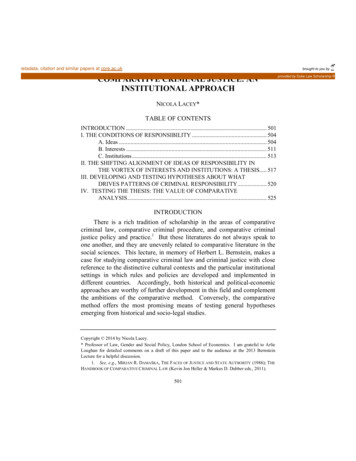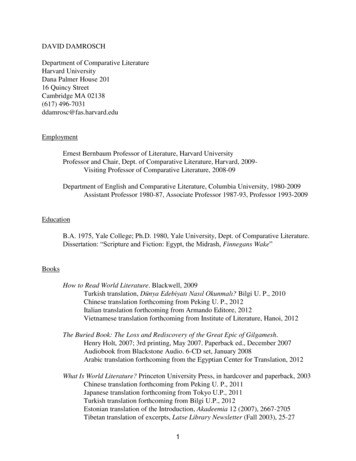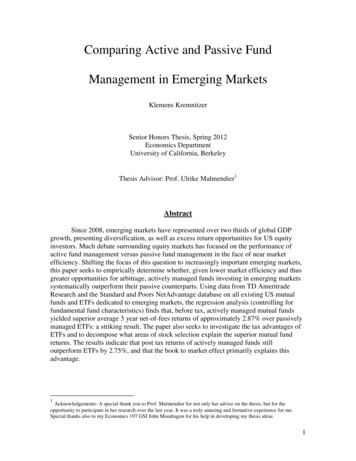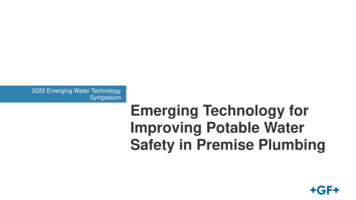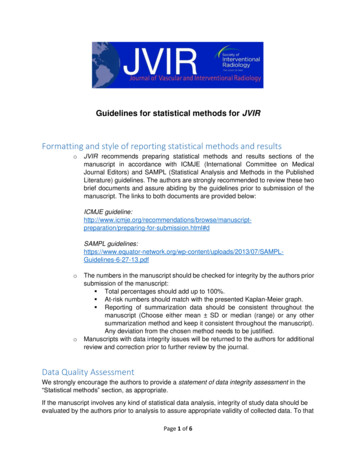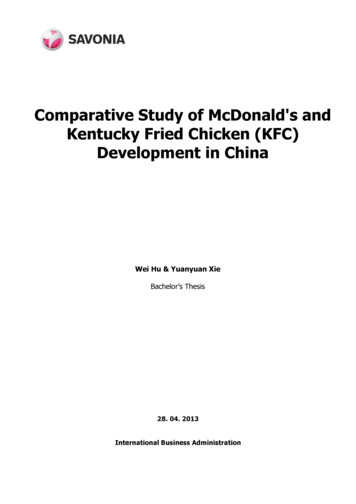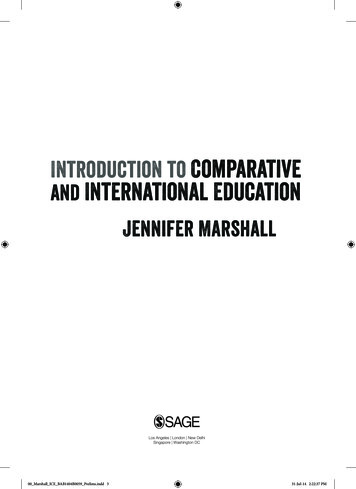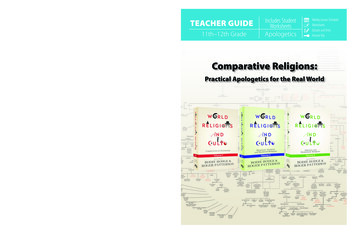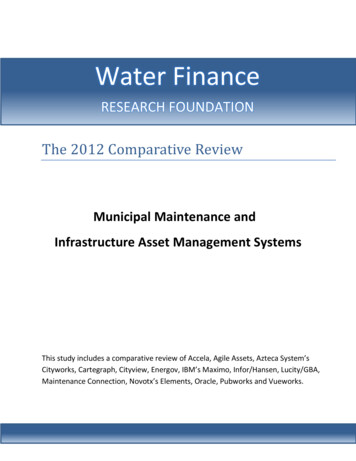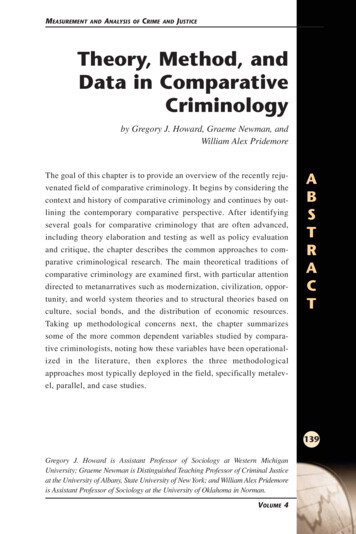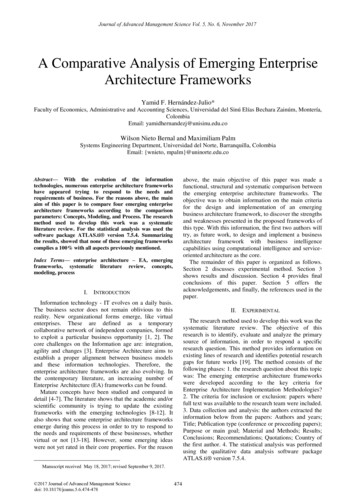
Transcription
Journal of Advanced Management Science Vol. 5, No. 6, November 2017A Comparative Analysis of Emerging EnterpriseArchitecture FrameworksYamid F. Hernández-Julio*Faculty of Economics, Administrative and Accounting Sciences, Universidad del SinúElías Bechara Zainúm, Montería,ColombiaEmail: yamidhernandezj@unisinu.edu.coWilson Nieto Bernal and Maximiliam PalmSystems Engineering Department, Universidad del Norte, Barranquilla, ColombiaEmail: {wnieto, mpalm}@uninorte.edu.coabove, the main objective of this paper was made afunctional, structural and systematic comparison betweenthe emerging enterprise architecture frameworks. Theobjective was to obtain information on the main criteriafor the design and implementation of an emergingbusiness architecture framework, to discover the strengthsand weaknesses presented in the proposed frameworks ofthis type. With this information, the first two authors willtry, as future work, to design and implement a businessarchitecture framework with business intelligencecapabilities using computational intelligence and serviceoriented architecture as the core.The remainder of this paper is organized as follows.Section 2 discusses experimental method. Section 3shows results and discussion. Section 4 provides finalconclusions of this paper. Section 5 offers theacknowledgements, and finally, the references used in thepaper.Abstract— With the evolution of the informationtechnologies, numerous enterprise architecture frameworkshave appeared trying to respond to the needs andrequirements of business. For the reasons above, the mainaim of this paper is to compare four emerging enterprisearchitecture frameworks according to the comparisonparameters: Concepts, Modeling, and Process. The researchmethod used to develop this work was a systematicliterature review. For the statistical analysis was used thesoftware package ATLAS.ti version 7.5.4. Summarizingthe results, showed that none of these emerging frameworkscomplies a 100% with all aspects previously mentioned. Index Terms— enterprise architecture – EA, emergingframeworks, systematic literature review, concepts,modeling, processI.INTRODUCTIONInformation technology - IT evolves on a daily basis.The business sector does not remain oblivious to thisreality. New organizational forms emerge, like virtualenterprises. These are defined as a temporarycollaborative network of independent companies, formedto exploit a particular business opportunity [1, 2]. Thecore challenges on the Information age are: integration,agility and changes [3]. Enterprise Architecture aims toestablish a proper alignment between business modelsand these information technologies. Therefore, theenterprise architecture frameworks are also evolving. Inthe contemporary literature, an increasing number ofEnterprise Architecture (EA) frameworks can be found.Mature concepts have been studied and compared indetail [4-7]. The literature shows that the academic and/orscientific community is trying to update the existingframeworks with the emerging technologies [8-12]. Italso shows that some enterprise architecture frameworksemerge during this process in order to try to respond tothe needs and requirements of these businesses, whethervirtual or not [13-18]. However, some emerging ideaswere not yet rated in their core properties. For the reason II.The research method used to develop this work was thesystematic literature review. The objective of thisresearch is to identify, evaluate and analyze the primarysource of information, in order to respond a specificresearch question. This method provides information onexisting lines of research and identifies potential researchgaps for future works [19]. The method consists of thefollowing phases: 1. the research question about this topicwas: The emerging enterprise architecture frameworkswere developed according to the key criteria forEnterprise Architecture Implementation Methodologies?2. The criteria for inclusion or exclusion: papers wherefull text was available to the research team were included.3. Data collection and analysis: the authors extracted theinformation below from the papers: Authors and years;Title; Publication type (conference or proceeding papers);Purpose or main goal; Material and Methods; Results;Conclusions; Recommendations; Quotations; Country ofthe first author. 4. The statistical analysis was performedusing the qualitative data analysis software packageATLAS.ti version 7.5.4.Manuscript received May 18, 2017; revised September 9, 2017. 2017 Journal of Advanced Management Sciencedoi: 10.18178/joams.5.6.474-478EXPERIMENTAL474
Journal of Advanced Management Science Vol. 5, No. 6, November 2017III.methodology. The results of the comparison aresummarized in table II and discussed below:RESULTS AND DISCUSSIONThe main aim of this article was to make a comparisonbetween these emerging frameworks according to thecriteria set by previous comparative studies (Table I).TABLE II. EMERGING FRAMEWORKS COMPARISON.TABLE I. COMPARED FRAMEWORKS BY THE erEAPFEAFTEAFLTGAFGERAME2AFLim, etal. [5] Rouhani,et al. [4] Sessions[6] Magoulas,et al. [7] AlignmentArtifactsGovernanceRepositoryStrategy The research unit decided to choose the more recentworks (2013, 2014) due to the quick advance oftechnologies and platforms and used the comparisoncriteria proposed by Rouhani, et al. [4]. Thesecomparison criteria are complemented with otherconcepts made by Zachman [20], who stated that aframework must be: Simple, Comprehensive, a language,a planning, a tool, a problem solving tools, Neutral.Winter and Fischer [21], whom argue that an EAframework provides: one or more meta-model(s) for EAdescription, one or more method(s) for EA design andevolution, a common vocabulary for EA, and maybe even,Reference models that can be used as templates orblueprints for EA design and evolution.The same authors state that the components of an EAframework should be applicable for a broad range ofcorporations and government agencies [21]. Thus, thefirst comparison criterion is Concepts: according toRouhani, et al. [4] EA concepts are generally addressed,including: definition of EA, alignment between businessand IT, importance of repository, the association andcommunication among artifacts and EAIM strategy,governance among others.The second parameter of the comparison is Modeling:a typical modeling comprises of the following majorcomponents: notation, syntax and semantics. Modelingdifferent perspectives of enterprise are significant part ofmodeling that need to utilize in EAIM. Consequently, byusing an appropriate modeling the EAIM could reducethe complexities of current and desired architecture, andtransition plan effectively [4].And the last one, is Process: For Rouhani, et al. [4],Enterprise Architecture Implementation Methodology –EAIM, emphasizes the set of process and parts performedas part of the EA life cycle. A useful EAIM should coverthe following stages, enterprise modeling, currentarchitecture analysis, desired architecture analysis,managing and providing detailed design of projects,describing controlled transition plan, and implementation.EAIM that covers all parts of the EA development byconsidering EA concepts is a consistent and complete 2017 Journal of Advanced Management Science475Easy to useEasy to learnTraceabilityConsistencyDifferent viewsComplexityDynamicEASCENARIOEASOA, BIGEAANAL ANALYT DATA AND INTELLIGYSIS ICS CLOUD ENCE Leyva- Schmidt, Zimmermann Veneberg,Vázqu et al. [22], et al. [18]et al. [23]ez, etal. LMMHLLMHMLMHMHLHLLPROCESSRequirementLMMLStep by stepLLLHLLHLDetailed eLLMLContinualLMMMAccording to Rouhani, et al. [4] the parameters are considered as below:H: high consideration or detailed and clear description. M: mediumconsideration or little description. L: low consideration or high leveldescription. * This part is included here because the author comparedEA implementation methodologies.Source: The evaluation was made by research unit.The work of Leyva-Vázquez, et al. [14] propose aframework for identification, analysis and ranking of EAfuture scenarios using fuzzy cognitive maps – FCM andOrdered weighted averaging - OWA. According to theauthors, scenario analysis helps to identify differentalternatives to attain a future state (useful for futuredecision support systems and knowledge managementsystem development). It is a strategic planning method tomake flexible planning, often used in enterprise-widetechnology management. By using the first technique,complex systems can be modeled and simulated. FCMincorporates ideas from artificial neural networks andfuzzy logic [24]. Provides a more flexible and morerealistic representation scheme for dealing withknowledge [25]. FCM also offers the modelingmechanism for linking the strategic goals with the ObjectOriented models [26] and the second one technique, canbe interpreted as a degree of risk acceptance [27].Decision maker risk attitudes can be then encoded in theform of OWA operators [14]. This framework wasdeveloped integrating knowledge from experts (thismeans that is necessary to have specialist or expertsacting in the modeling process). The disadvantage frommodeling with FCM is the lack of quantitative analysis of
Journal of Advanced Management Science Vol. 5, No. 6, November 2017decision makers is stressed. However, the method iscurrently restricted to decision support and targetachievement control. It does not consider the overallstrategy of the enterprise, nor does it provide guidance onhow to actually make changes in the EA. Thus, only afew indicators get a high rating as the majority of EAIMattributes is not very well supported.As summary of the results, we can state that theframeworks with higher score in all aspects from thecomparison criteria is the work of Schmidt, et al. [22],followed by Veneberg, et al. [23] and the last two, areZimmermann, et al. [18] and Leyva-Vázquez, et al. [14],respectively. The framework with the worst evaluation(lower score) is the work of Leyva-Vázquez, et al. [14].According to the main criteria, in concepts: almostmost of mentioned frameworks cover all concepts.Alignment and Artifacts are supported by most selectedframeworks; in contrast Repository and Strategy were notutilized in most of frameworks. (These results differ withthose obtained by Rouhani, et al. [4]). In modeling: theworks of Schmidt, et al. [22] and Veneberg, et al. [23] arein same situation (high and medium grade). The work ofLeyva-Vázquez, et al. [14] has fluctuates situation (insome attributes has medium grade and in the others haslow grade) and the work of Zimmermann, et al. [18] hasthe lower grade in this category. Selected frameworks donot have specific plan for depiction complexity anddynamic aspects of EA (These results are similar toobtained by Rouhani, et al. [4]. In process: in thiscategory, the results are very different to obtained by [4]because the authors evaluated Enterprise ArchitectureImplementation Methodologies – EAIMs and the selectedemerging enterprise architecture frameworks are notimplementation methodologies. However, the parametersalso are usable for the comparison. Step by step structure,detailed design, implementation, guidelines andmaintenance are the lower attributes in the selectedframeworks. They need to consider more due to lack ofconsideration in most of the evaluated frameworks.Requirement and Continual are most usable attribute inthe selected frameworks.results for ranking of alternatives [28]. The authorsmentioned those properties from the techniques, however,in the framework is not visible this alignment between thestrategic goals and the business model. For these reasons,the rating for the EAIM indicators are generally in low.Majority of the implementation process are low becausethey didn’t propose an implementation methodology.The work of Schmidt, et al. [22] introduce aframework for enterprise architecture analytics, which weare integrating from an extended service-orientedenterprise architecture reference model in the context ofBig Data analytics for architecture, new decision supportsmethods for architecture alignment, and an originalarchitecture maturity approach. This framework wasmade using fundamental concepts and definitions fromSoftware Architecture, Architecture Reference Model,Reference Architecture, Service-oriented EnterpriseArchitectures, architectures for Services Computing andCloud Computing, Cloud Reference Architectures fromdifferent authors. The Enterprise Services ArchitectureReference Cube – ESARC was their growing originalService oriented Enterprise Architecture ReferenceModel, which provides an integral EAM model for maininterweaved architectural viewpoints. According to theauthors, this framework leverages the huge amounts ofdata available in today’s virtualized infrastructures andexploits those using technologies from the context of BigData. By this means, it is possible to use both semi- tunately, the authors did not apply the proposedframework in a real industry sector. As a future work,they want to evaluate their framework in differentcontexts, and investigate how to establish a suitableinformation and decision support basis for Industry orother context specific criteria implementing an empiricalstudy observing and evaluating risks of a data drivenanalysis (e.g. forecast error, metric problems).The Zimmermann, et al. [18] work provides a set ofreference architectures and architecture reference modelsgeared towards a cloud-based SOA for Big Dataapplications. The so-called Business and InformationReference Architecture (BIRA) support alignment ofbusiness and IT. The reference models presented includedifferent viewpoints and can be used for the detaileddesign of enterprise-specific architectures. To a certaindegree, quality assurance and continual improvement arediscussed. However, the authors do not provide a methodto derive a company-specific architecture, nor do theyshow how to implement one. Hence, the ratings for theEAIM indicators are generally on the lower end of thescale.Veneberg, et al. [23] propose a method for solvingbusiness concerns using combined information fromoperational and EA data. A step by step explanation isgiven and each activity has a defined set of input andoutput documents. As the method is applied to supportdecision making, reduction of complexity is supported inseveral steps. For example, the number of examined datasources and EA elements is reduced as much as possibleand the importance of adequate data visualization for 2017 Journal of Advanced Management ScienceIV.CONCLUSIONSThis paper presented a comparative analysis ofemerging Enterprise Architecture Frameworks based onthe Rouhani, et al. [4] comparison parameters. Asconclusion of the paper we can state that none of theemerging frameworks are fully completed, all of themhave strengths and weaknesses. According to results,none of the compared works complies a 100% with allaspects mentioned by Zachman [20], Winter and Fischer[21] and Rouhani, et al. [4]. Our recommendation forfuture work is to try to get the strengths of the betterframework (higher score items) and trying to obliteratetheir weaknesses (step by step, detailed design,implementation and guidelines). It would be great if theenterprise architects began using hybrid frameworks anddocumenting their experiences. This information is veryrelevant for the first two authors, because they want topurpose an emerging enterprise architecture framework476
Journal of Advanced Management Science Vol. 5, No. 6, November 2017ACKNOWLEDGMENTusing computational intelligence and service-orientedarchitecture as core for the development of businessintelligence.The first author expresses its deep thanks to theAdministrative Department of Science, Technology andInnovation – COLCIENCIAS of Colombia and theUniversidad del Norte for the Doctoral scholarship. Alsoexpresses their deep thanks to the Universidad del SinúElías Bechara Zainúm for the scholar and financialsupport.APPENDIX A TAXONOMY OF THE FOUND WORKSAccording to the main objectives (or goals) and titlesof the found works (papers), they were classified asfollow:a. EmergingFrameworks:Thiscategoryrepresents all jobs that design, redesign orimprove any previously established framework(i.e. TOGAF, EAP, Zachman, etc.) using newtechniques or procedures with the primary goal ofimproving the integration of all layers anenterprise architecture (infrastructure, data,applications, business, strategies). This categoryincludes the work of [13], [14], [29], [22], [23],[3], [30], [15], [16], [17] and [18].b. Methods for improvement or redesignEnterprises Architectures Frameworks: It isimportant to mention that this category couldinclude some emerging frameworks because theymay propose any kind of improvement orredesign of any component of the EAF. Thiscategory includes the works of [31], [23], [32],[33], [34], [35], [36] and [37].c. FrameworksUsingServiceOrientedArchitecture – SOA: This category includesworks of [38], [3], [39], [13], [18], [16] and [30].d. Frameworks for Decision Making support: Forthis category, the authors found the works of [14],[36], [23] and [40].e. Frameworks using Cloud Computing: Thisincludes the works of [22], [13], [3] and [18].f.Frameworks using or designing software forreference model: Include the works of [41], [42]and [43].g. Frameworks using Ontologies: For this categorywere found the works of [36] and [44].h. Frameworks to evaluate maturity models ofEnterprise Architecture: In this category we canfind the works of [33] and [22].i.Works evaluating quality attributes: Withinthis category, the authors found works of [5] and[40].j.Works Modeling Contextual concerns: We canfind the works of [45] and [42].k. Works making comparison between EAs: Inthis category we found the works of [5] and [4].l.Frameworks using Resilience: This categorywas included because [30] presented this work atthe 2009 IEEE International Systems ConferenceProceedings in Vancouver - Canada.m. Works with EA complements: This category isrepresented by [46].n. Institutionalization of EA: This is representedby [47].o. Emphasize on Architects skills: In this category,we count with the work of [48] 2017 Journal of Advanced Management 1][12][13][14][15][16][17]477J. Browne and J. Zhang, "Extended and virtual enterprisessimilarities and differences," International Journal of AgileManagement Systems, vol. 1, pp. 30-36, 1999.H. Helaakoski, P. Iskanius, and I. Peltomaa, "Agent-basedarchitecture for virtual enterprises to support agility," inEstablishing the Foundation of Collaborative Networks, ed:Springer, 2007, pp. 299-306.A. Goel, H. Schmidt, and D. Gilbert, "Towards formalizingVirtual Enterprise Architecture," in Enterprise Distributed ObjectComputing Conference Workshops, 2009. EDOCW 2009. 13th,2009, pp. 238-242.B. D. Rouhani, M. N. Mahrin, F. Nikpay, and P. Nikfard, thodologies," in Proceedings - 2013 International Conferenceon Informatics and Creative Multimedia, ICICM 2013, 2013, pp.1-6.N. Lim, T. G. Lee, and S. G. Park, "A comparative analysis ofenterprise architecture frameworks based on EA qualityattributes," in 10th ACIS Conference on Software Engineering,Artificial Intelligence, Networking and Parallel/DistributedComputing, SNPD 2009, In conjunction with IWEA 2009 andWEACR 2009, 2009, pp. 283-288.R. Sessions. (2007, September). Comparison of the Top FourEnterprise Architecture Methodologies. [Online]. /bb466232.aspxT. Magoulas, A. Hadzic, T. Saarikko, and K. Pessi, "Alignment inenterprise architecture: A comparative analysis of fourarchitectural approaches," Electronic Journal Information SystemsEvaluation, vol. 15, 2012.Department of Defense CIO-Council, "The DoDAF ArchitectureFramework Version 2.02," Defense, Ed., ed. Washington, D.C.:Department of Defense USA, 2010, p. 289.Department of the Treasury CIO-Council, "Treasury EnterpriseArchitecture Framework Version 1," vol. 1, ed: Department of theTreasury CIO-Council, 2000, p. 164.Federal CIO-Council, "Federal enterprise architecture frameworkversion 2.0," ed. Washington, DC: Federal CIO, 2013, p. 434.A. Josey, "TOGAF Version 9.1. Enterprise Edition: AnIntroduction," in TOGAF Version 9.1, D. Hornford, T. Paider, C.Forde, A. Josey, G. Doherty, and C. Fox, Eds., ed. San Francisco,CA, USA: The Open Group, 2011, p. 13.J. A. Zachman. (2008, 11/11). John Zachman's Concise kL. Tang, J. Dong, Y. Zhao, and L. J. Zhang, "Enterprise CloudService Architecture," in Proc. 2010 IEEE 3rd InternationalConference on Cloud Computing, CLOUD 2010, 2010, pp. 27-34.M. Leyva-Vázquez, K. Pérez-Teruel, and R. I. John, "A model forenterprise architecture scenario analysis based on fuzzy cognitivemaps and OWA operators," in Proc. CONIELECOMP 2014 - 24thInternational Conference on Electronics, Communications andComputers, 2014, pp. 243-247.G. Mingxin and S. Lily, "Dynamic convergence of business andIT systems through enterprise isomorphic architecture," in Proc.2009 International Conference on Information Technology andComputer Science, ITCS 2009, 2009, pp. 366-369.E. Najafi and A. Baraani, "KASRA Framework: A ServiceOriented Enterprise Architecture Framework (SOEAF)," inServices (SERVICES-1), 2010 6th World Congress on, 2010, pp.172-173.M. Bahrami, M. Shahrazadfard, and T. Kerdkar, "NSSA: A newenterprise architecture for network setup without any network
Journal of Advanced Management Science Vol. 5, No. 6, November 9][30][31][32][33][34]infrastructure," in Proc. 2011 Second International Conference on,Intelligent Systems, Modelling and Simulation (ISMS), 2011, pp.95-99.A. Zimmermann, M. Pretz, G. Zimmermann, D. G. Firesmith, I.Petrov, and E. El-Sheikh, "Towards service-oriented enterprisearchitectures for big data applications in the cloud," in Proc. 201317th IEEE International on Enterprise Distributed ObjectComputing Conference Workshops (EDOCW), 2013, pp. 130-135.B. Kitchenham, "Guidelines for performing systematic literaturereviews in software engineering," Keele University, Keele (UK)Technical report, EBSE Technical Report EBSE-2007-01, 2007.J. A. Zachman, "Concepts of the framework for enterprisearchitecture," Zachman International Inc., La Cañada, CA, pp. 1-6,1996.R. Winter and R. Fischer, "Essential layers, artifacts, anddependencies of enterprise architecture," in Proc. EnterpriseDistributed Object Computing Conference Workshops, EDOCW'06. 10th IEEE International, 2006, pp. 30-30.R. Schmidt, M. Wissotzki, D. Jugel, M. Mohring, K. Sandkuhl,and A. Zimmermann, "Towards a framework for enterprisearchitecture analytics," in Proc. 2014 IEEE 18th InternationalEnterprise Distributed Object Computing Conference Workshopsand Demonstrations (EDOCW), 2014, pp. 266-275.R. K. M. Veneberg, M. E. Iacob, M. J. V. Sinderen, and L.Bodenstaff, "Enterprise architecture intelligence: Combiningenterprise architecture and operational data," in Proc. IEEEInternational Enterprise Distributed Object Computing Workshop,EDOCW, 2014, pp. 22-31.L. Chin-Teng and C. S. G. Lee, "Neural-network-based fuzzylogic control and decision system," IEEE Transactions onComputers, vol. 40, pp. 1320-1336, 1991.L. Zhi-Qiang, "Causation, bayesian networks, and cognitivemaps," Acta Automatica Sinica, vol. 04, pp. 552-566, 2001.K. K. Dimitris and K. Bill, "Fuzzy modelling for integratedstrategic planning for information systems and business processdesign," in Strategic Information Technology and PortfolioManagement, T. Albert Wee Kwan and T. Petros, Eds., edHershey, PA, USA: IGI Global, 2009, pp. 59-77.D. Filev and R. R. Yager, "On the issue of obtaining OWAoperator weights," Fuzzy Sets and Systems, vol. 94, pp. 157-169,3/1/ 1998.M. Y. Leyva Vázquez, K. Y. Pérez Teurel, A. Febles Estrada, andJ. Gulín González, "Modelo para el análisis de escenarios basadosen mapas cognitivos difusos: estudio de caso en softwarebiomédico," 2013, vol. 17, p. 16, 2013-06-11 2013.M. A. Mohamed, G. H. Galal-Edeen, H. A. Hassan, and E. E.Hasanien, "An evaluation of enterprise architecture frameworksfor E-government," in Proc. ICCES 2012: 2012 InternationalConference on Computer Engineering and Systems, 2012, pp. 255260.O. Erol, M. Mansouri, and B. Sauser, "A framework for enterpriseresilience using service oriented architecture approach," in 2009IEEE International Systems Conference Proceedings, Vancouver,Canada, 2009, pp. 127-132.J. Petrikina, P. Drews, I. Schirmer, and K. Zimmermann,"Integrating business models and enterprise architecture," in Proc.2014 IEEE 18th International on Enterprise Distributed ObjectComputing Conference Workshops and Demonstrations(EDOCW) , 2014, pp. 47-56.R. A. Razak, Z. M. Dahalin, H. Ibrahim, N. I. Yusop, and M. K.Kasiran, "Investigation on the importance of enterprisearchitecture in addressing business issues," in Proc. 2011International Conference on Research and Innovation inInformation Systems, ICRIIS'11, 2011.J. Lakhrouit and K. Baina, "State of the art of the maturity modelsto an evaluation of the enterprise architecture," in ISKO-Maghreb,2013 3rd International Symposium, 2013, pp. 1-8.A. Akkasi, F. Shams, and M. A. seyyedi, "Presenting a method forbenchmarking application in the enterprise architecture planning 2017 Journal of Advanced Management [45][46][47][48]process based on federal enterprise architecture framework," inProc. Information and Communication Technologies: FromTheory to Applications, 2008. ICTTA 2008. 3rd InternationalConference on, 2008, pp. 1-6.O. E. Balcicek, M. Gundebahar, and S. Cekerekli, "An agileapproach for converting enterprise architectures," in 2013 TheInternational Conference on Technological Advances in Electrical,Electronics and Computer Engineering, TAEECE 2013, 2013, pp.380-386.M. Bakhshandeh, G. Antunes, R. Mayer, J. Borbinha, and A.Caetano, "A modular ontology for the enterprise architecturedomain," in Proc.IEEE International Enterprise DistributedObject Computing Workshop, EDOC, 2013, pp. 5-12.F. Anajafi, R. Nassiri, and G. L. Shabgahi, "Developing effectiveproject management for enterprise architecture projects," in ICSTE2010 - 2010 2nd International Conference on SoftwareTechnology and Engineering, Proceedings, 2010, pp. V1388V1393.Y. Zhao, "Enterprise service oriented architecture (esoa) adoptionreference," in Services Computing, 2006. SCC'06. IEEEInternational Conference on, 2006, pp. 512-512.S. Nurcan and R. Schmidt, "Service oriented enterprisearchitecture for enterprise engineering introduction," in Proc.Enterprise Distributed Object Computing Conference Workshops,2009. EDOCW 2009. 13th, 2009, pp. 247-253.M. Österlind, P. Johnson, K. Karnati, R. Lagerström, and M. Välja,"Enterprise architecture evaluation using utility theory," in Proc.IEEE International Enterprise Distributed Object ComputingWorkshop, EDOC, 2013, pp. 347-351.G. Plataniotis, S. De Kinderen, and H. A. Proper, "Relatingdecisions in enterprise architecture using decision Design graphs,"in Proc. 2013 17th IEEE International Enterprise DistributedObject Computing Conference (EDOC), , 2013, pp. 139-146.P. Petrov, U. Buy, and R. L. Nord, "The need for a multilevelcontext-aware software architecture analysis and design methodwith enterprise and system architecture concerns as first classentities," in Proc. 2011 9th Working IEEE/IFIP Conference onSoftware Architecture (WICSA), , 2011, pp. 147-156.A. Zimmermann, H. Buckow, H. J. Groß, O. F. Nandico, G. Piller,and K. Prott, "Capability diagnostics of enterprise servicearchitectures using a dedicated software architecture referencemodel," in Proc. 2011 IEEE International Conference on ServicesComputing, SCC 2011, 2011, pp. 592-599.Isbandi and Albarda, "Design of information architecture withenterprise ontology approach: A case study in West JavaEducational Quality Assurance Institution," in Proc. InternationalConference on ICT for Smart Society 2013: "Think Ecosystem ActConvergence," 2013, pp. 42-47.G. Antunes, J. Barateiro, C. Becker, J. Borbinha, and R. Vieira,"Modeling contextual concerns in enterprise architecture," in Proc.2011 15th IEEE International Enterprise Distributed ObjectComputing Conference Workshops (EDOCW), 2011, pp. 3-10.S. Buckl, A. M. Ernst, F. Matthes, R. Ramacher, and C. M.Schweda, "Using enterprise architecture management patterns tocomplement TOGAF," in Proc. 13th IEEE InternationalEnterprise Distributed Object Computing Conference, EDOC2009, 2009, pp. 34-41.L. Chung, H. K. Song, Y. T. Song, and N. Subramanian,"Understanding the role of enterprise architecture towards betterinstitutionalization," in Proc. 10th ACIS Conference on ingandParallel/Distributed Computing, SNPD 2009, In conjunction withIWEA 2009 and WEACR 2009, 2009, pp. 316-320.R. Wagter, H. A. Proper, and D. Witte, "Enterprise architecture: Astrategic specialism," in Proc. the 2012 IEEE 14th InternationalConference on Commerce and Enterprise Computing, CEC 2012,2012, pp. 1-8.
Enterprise Architecture (EA) frameworks can be found. Mature concepts have been studied and compared in detail [4-7]. The literature shows that the academic and/or scientific community is trying to update the existing frameworks with the emerging technologies [8-12]. It also shows that some enterprise architecture frameworks
